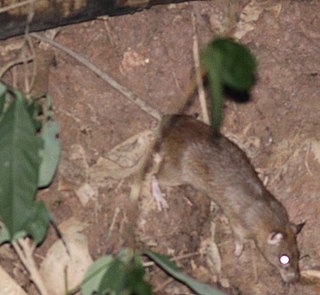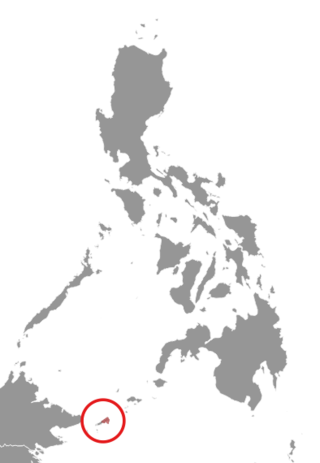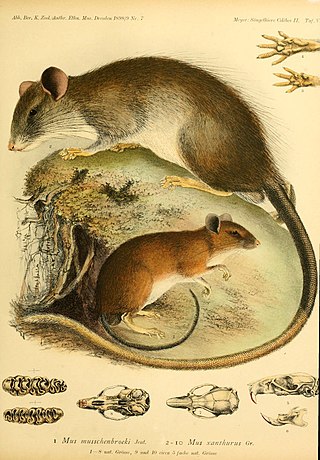
Mitochondrial DNA is the DNA located in mitochondria, cellular organelles within eukaryotic cells that convert chemical energy from food into a form that cells can use, such as adenosine triphosphate (ATP). Mitochondrial DNA is only a small portion of the DNA in a eukaryotic cell; most of the DNA can be found in the cell nucleus and, in plants and algae, also in plastids such as chloroplasts.

Human mitochondrial genetics is the study of the genetics of human mitochondrial DNA. The human mitochondrial genome is the entirety of hereditary information contained in human mitochondria. Mitochondria are small structures in cells that generate energy for the cell to use, and are hence referred to as the "powerhouses" of the cell.
Annandale's rat is a species of rodent in the family Muridae. It is found in Indonesia (Sumatra), Peninsular Malaysia, and Singapore. It was classified as Rattus annandalei until 2017, but mitochondrial and nuclear DNA show that it belongs to the rat genus Sundamys.
The Bonthain rat or southwestern xanthurus rat is a species of rodent in the family Muridae. It is found only in southwestern Sulawesi, Indonesia.
The Enggano rat is a species of rodent in the family Muridae. It is found only on Enggano Island, Indonesia. It is critically endangered.

The Philippine forest rat is a species of rodent in the family Muridae. It is found only in the Philippines, and is located throughout the archipelago. The scientific name commemorates British colonial administrator and zoological collector Alfred Hart Everett. The Chanum Torres is widespread throughout its range and feeds on a diet of worms and insects. There are no major threats to the species, which has been found to be competitively superior to introduced Rattus species.

Hoffmann's rat is a species of rodent in the family Muridae. It is found only in Indonesia, and is located throughout Sulawesi, as well as Malenge island in the Togian Islands.
Hoogerwerf's rat is a species of rodent in the family Muridae. It is named after zoologist Andries Hoogerwerf and is found only in western Sumatra, Indonesia, including Mount Leuser, where it is found only above 2000 m. It is known from few museum specimens. Genetic analysis indicate its closest relative is Rattus korinchi, another Sumatran mountain rat from which it diverged around 1.4 million years ago.
Korinch's rat is a species of rodent in the family Muridae. It is found only in western Sumatra, Indonesia, and is only known from Mount Kerinci and Mount Talakmau, where it is endemic to high elevations above 2000 m. It is only known from two museum specimens collected early in the 20th century. Genetic analysis indicate its closest relative is, another Sumatran mountain rat from which it diverged around 1.4 million years ago.

The lesser ricefield rat is a rodent in the family Muridae. The species was first described by Robert Swinhoe in 1871. It is found in China, Laos, Taiwan, Thailand, and Vietnam.
The eastern rat is a species of rodent in the family Muridae.
The Molaccan prehensile-tailed rat is a species of rodent in the family Muridae. It is found only in the Halmahera Islands of Indonesia, including Morotai, Halmahera, and Batjan islands.
The palm rat is a species of rodent in the family Muridae. It is found in the Nicobar Islands, on Car Nicobar and Great Nicobar islands.
The Simalur rat is a species of rodent in the family Muridae. It is found only in Indonesia, on Simalur island and the nearby islands of Siumat, Lasia, and Babi
Stein's rat, also known as the small spiny rat, is a species of rodent in the family Muridae. It is found in West Papua, Indonesia and Papua New Guinea.

The Tanezumi rat, also known as the Asian rat or Asian house rat, is a species of rodent in the family Muridae. It is closely related to the black rat. It is widespread in eastern, southern and south-eastern Asia, being found in Bangladesh, Bhutan, Cambodia, China, Cocos (Keeling) Islands, Fiji, India, Indonesia, Japan, North Korea, South Korea, Laos, Malaysia, Myanmar, Nepal, the Philippines, Taiwan, Thailand, and Vietnam.

The Tawitawi forest rat or Tawitawi Island rat is a species of rodent in the family Muridae. It is found only in Tawi-Tawi, Philippines.

The yellow-tailed rat is a species of rodent in the family Muridae. It is found only in northeastern Sulawesi, Indonesia.
The slender rat is a species of rodent in the family Muridae. It is found in West Papua, Indonesia and Papua New Guinea.

Mitochondrially encoded 12S ribosomal RNA is the SSU rRNA of the mitochondrial ribosome. In humans, 12S is encoded by the MT-RNR1 gene and is 959 nucleotides long. MT-RNR1 is one of the 37 genes contained in animal mitochondria genomes. Their 2 rRNA, 22 tRNA and 13 mRNA genes are very useful in phylogenetic studies, in particular the 12S and 16S rRNAs. The 12S rRNA is the mitochondrial homologue of the prokaryotic 16S and eukaryotic nuclear 18S ribosomal RNAs. Mutations in the MT-RNR1 gene may be associated with hearing loss. The rRNA gene also encodes a peptide MOTS-c, also known as Mitochondrial-derived peptide MOTS-c or Mitochondrial open reading frame of the 12S rRNA-c.







